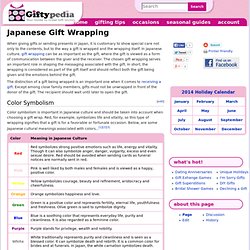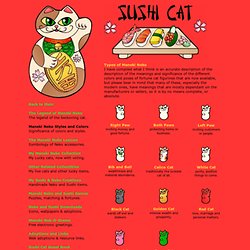

StumbleUpon. Japanese Gift Wrapping - Giftypedia. When giving gifts or sending presents in Japan, it is customary to show special care not only to the contents, but to the way a gift is wrapped and the wrapping itself.

In Japanese culture, gift wrapping can be as important as the gift, where the gift is viewed as a form of communication between the giver and the receiver. The chosen gift wrapping serves an important role in shaping the messaging associated with the gift. In short, the wrapping is considered as part of the gift itself and should reflect both the gift being given and the emotions behind the gift. The distinction of a gift being wrapped is an important one when it comes to receiving a gift. Except among close family members, gifts must not be unwrapped in front of the donor of the gift.
[edit] Color Symbolism Color symbolism is important in Japanese culture and should be taken into account when choosing a gift wrap. [edit] Styles of Japanese Gift Wrapping There are two main Japanese gift wrapping techniques... Japan Guide. Touring the Tiniest Town in Japan. You don’t know inaka until you have visited the smallest town in Japan: Aogashima.

This tiny island is technically still part of Tokyo, and is the southernmost tip of the Izu Island chain. The population hovers around 170 and on the "stuff to do" scale, it sits somewhere just above 1. The island is accessible by a scenic helicopter ride or by ferry, and it’s a great place to spend a day or two. Aogashima’s main attraction is its geologic anomaly, the double volcano. The island itself is one volcano, and another smaller volcano sits inside the caldera of it. Ginza, Tokyo, Japan
Ginza Tokyo Ginza, the "Times Square" of Tokyo the guardian at the entrance to the department store a shopper where one can lock up the umbrella while shopping many elegant restaurants but also McDonalds Ginza, an entertainment center the subway line what this restaurant has to offer Ginza Station of the Tokyo Metro shop signs.

5 Steps To Ordering a Meal in Japan. I live in Japan, but barely speak Japanese. I can’t help you with verb conjugation or passing the JLPT. But I have managed to eat! Restaurants in Japan are a culinary and cultural adventure. Knowing how to act is crucial to speaking the language. They’re also great places to practice many facets of conversational Japanese! So, here are 5 steps to ordering food in Japan.
Find a Place to Eat Most foreigners know about sushi and ramen. Yakitori Udon (うどん), a noodle usually served in soupSoba (そば), a thin buckwheat noodle (which is sometimes served cold)Okonomiyaki (お好み焼き), a vegetable-meat-and-egg pancake with a sweet brown sauceYakitori (やきとり), a kebab usually on a stickYakiniku (焼き肉), where you grill your own meat at your tableYakisoba (焼きそば), a stir-fried noodle dish with barbecue sauce and pork You’ll see plastic replicas of the food outside of most restaurants, so even if you can’t read Japanese, you’ll have some idea of what to expect.
Get A Table Back Street Japanese Restaurant. Guide to Japanese manners and etiquette- Wa-pedia. Maneki Neko - The Meaning behind colors and types of Maneki Neko Fortune Cats. Types of Maneki Neko I have compiled what I think is an accurate description of the description of the meanings and significance of the different colors and poses of fortune cat figurines that are now available, but please bear in mind that many of these, especially the modern ones, have meanings that are mostly dependant on the manufacturers or sellers, so it is by no means complete, or absolute.

If you are interested in learning more about the significance of items often posed with Maneki Neko, please visit the Maneki Neko Lexicon. Legend - Types - Lexicon - Collection - Other - Creations - GamesDownloads - E-Cards - Adoptions & Links - Guest Book - Email Sushi Cat and all materials provided within are ©opyright protected. Original images and text may not be used without written permission provided by the author.